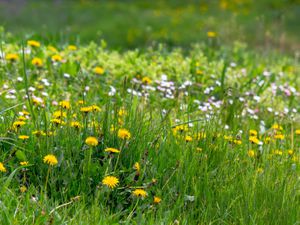Allowing a patch of grass in gardens to grow long helps butterflies, study finds
Butterfly Conservation scientists urge gardeners to let some of their garden go wild to help declining species.

Letting parts of your garden go wild with long grass boosts butterflies – particularly in towns and intensively farmed areas, a study has found.
Research from wildlife charity Butterfly Conservation analysing butterfly sightings from more than 600 gardens around Britain found a small but significant increase in butterfly numbers and species in gardens with a patch of long grass – and the more long grass, the more benefit.
The study found a boost to wildlife is likely to be biggest in highly arable areas, where gardens with long grass could see up to 93% more butterflies, while those in urban areas with long grass could boost numbers by up to 18%.
The Butterfly Conservation scientists behind the report said it proved for the first time that letting a patch of garden grass grow long could help the insects.
Private gardens make up 728,000 hectares (nearly 1.8 million acres) of land across Great Britain.

So while the increase in butterfly numbers in each garden was small, letting a patch in many gardens across the country go wild could make a huge difference to butterflies species, many of which are in decline, the researchers said.
The analysis showed increases in species which feed or breed in grass – such as gatekeepers, meadow browns, speckled wood and large and small skipper butterflies – suggesting long grass could provide habitat to help boost populations.
And the results are likely to be replicated if wildlife-friendly measures are implemented in other green spaces, such as parks, cemeteries and road verges, the paper said.
The study, published in the journal Science of the Total Environment, drew on six years of data from the citizen science “garden butterfly survey”, in which householders survey their garden for butterflies a number of times throughout the year.
It also looked at the land around each participating garden, to assess whether it was arable land, woodland, urban or suburban or grassland, and information from those taking part about the size of their garden, the amount of long grass in it and whether they have flowering ivy.
As well as an increase in butterflies linked to long grass, the study found that the presence of flowering ivy in gardens increased the number of certain butterfly species that feed or breed on ivy, such as holly blue, red admiral and comma.
Dr Richard Fox, head of science at Butterfly Conservation and co-author of the study, said: “Nature is in crisis; 80% of butterflies have declined since the 1970s, so we need to take action now to protect them.
“We wanted to be able to give tried and tested gardening advice that will benefit butterflies as we know lots of people want to help.
“This study proves, for the first time, that allowing a patch of grass to grow long will attract more butterflies into your garden.”
He added: “The simple act of creating wild spaces by allowing a patch of grass to grow long, or a border edge to go wild is free and easy to do, and can significantly boost butterfly numbers, especially in urban and agricultural settings where they are most under pressure.
“The benefits of each individual wild space are small, but if thousands of people get involved the boost to butterflies could be huge.”





